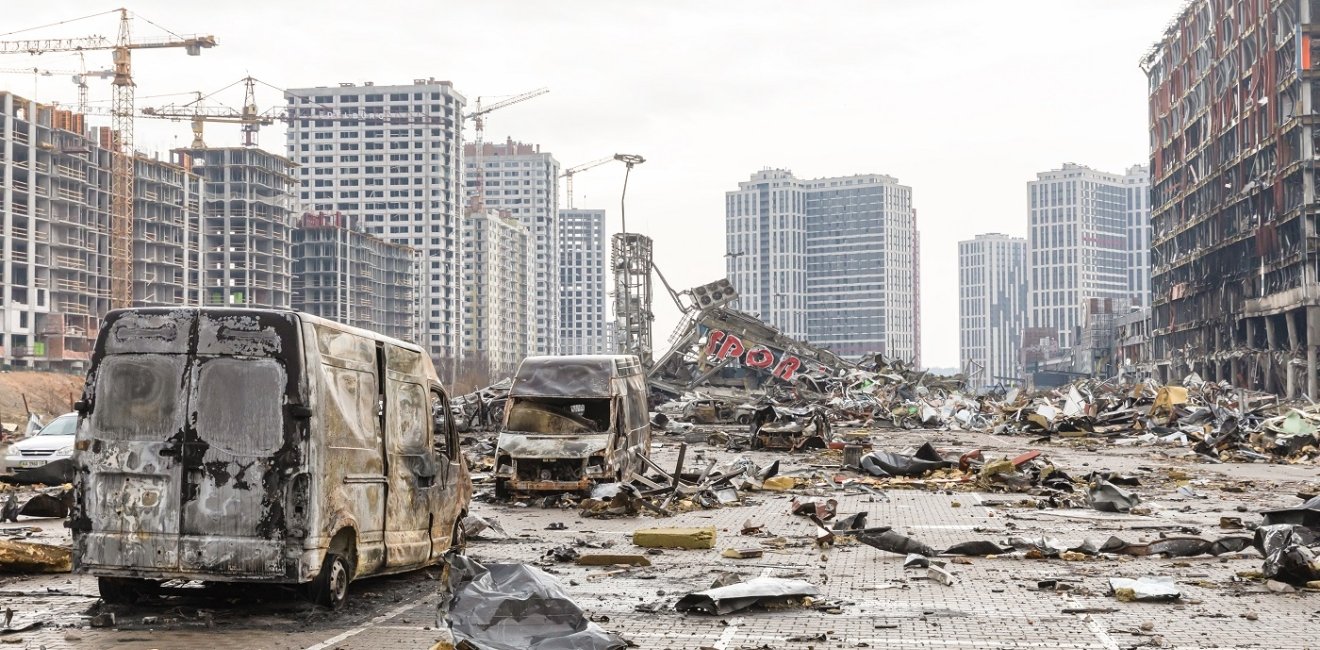
A blog of the Kennan Institute
BY KATERINA SERGATSKOVA
The Armed Forces of Ukraine recently made a major breakthrough in their counterattack operation in the east and have pushed the Russian army back dozens of kilometers from towns and villages that were under occupation. The military was able to regain control of the city of Izyum in the Kharkiv region, which is an important link in the operation to de-occupy Donbas. Dozens of settlements had been under Russian occupation for more than six months. What will the world see when these territories are liberated?
The first thing the world saw after the Russian army fled the Kyiv and Chernihiv regions in early April were the bodies of dead people in the middle of the streets. You probably remember pictures from Bucha and Irpin: a woman on a bicycle killed by a tank shot; families with children shot in cars while trying to leave the surrounded city; mass graves; volunteers and military personnel tortured by Russian soldiers. There was evidence of forced abductions, rapes, and looting. In just one month, the occupiers killed hundreds of people and mutilated the lives of tens of thousands who were “in the wrong place at the wrong time.”
What is happening to residents of cities that have been under occupation for months? In the first months of the occupation in Izyum, according to eyewitness accounts, the Russian military shot up cars that "inopportunely" passed by tanks. Communal services did not work, so both bodies and blown-up cars remained outside for a long time. Locals said they saw fresh burials in the yards near children's playgrounds. We can only speculate about the causes of death: some died a natural death, some from shelling, and some at the hands of marauders who looted stores and warehouses.
In Kherson, one of the largest cities in southern Ukraine, as in many other places in the region, rallies against the Russian invasion occurred almost every day during the first month of the occupation. Hundreds of people took to the streets to protest, even though there were armed men and military vehicles in front of them. Over time, the protests subsided: Russian FSB officers began visiting activists' homes. Dozens of activists disappeared, and their fate is still unknown. Some were held for weeks in prisons and tortured to give up information about the underground resistance and the Ukrainian military. With the help of local collaborators, the Russian security services compiled lists of potential partisans and dissenters, checked them at checkpoints on the way out of the occupied cities, and conducted so-called "filtration.” Many men who ended up in "filtration camps" are still missing.
Citizens who were able to evacuate from the occupation say that the Russian military checks the contents of the bags of everyone leaving, reads their cell phone correspondence, forces them to undress to check their tattoos, and conducts hours of interrogations. People have even begun to cover their patriotic, pro-Ukrainian or just controversial tattoos so that they won't have problems at checkpoints.
In major cities, the Russians have created military patrols: armed soldiers walk in groups in the streets and monitor how the locals behave. A person can be arrested for any criticism of these soldiers or patrols.
Residents of occupied towns also say that looting is rampant there. Businesses and goods were taken from entrepreneurs and farmers who refused to cooperate with the occupiers. In the first days, says an athlete with disabilities who was evacuated from Kherson in August, Russians looted warehouses of food and household equipment. They took from farmers either part of their crops or everything they had and told them that they could only work in the fields if they cooperated with the new authorities on their terms.
The occupation has caused a major humanitarian crisis. Most of the citizens left in the Russian-occupied territories have no jobs and no money left to live on, and pensioners are unable to receive pensions because the state postal service cannot deliver. They procure food, clothing, and medicine at humanitarian aid points, which are delivered mostly from Russian territories. Many doctors have evacuated, and it is only possible to get emergency medical care (and even that is not guaranteed). Life in the cities where the Russian army has arrived can only be called survival, and the longer the occupation lasts, the harder it is to survive.
In Crimea, Donetsk, and Luhansk, the occupation regime was established back in 2014. The scale of the disaster was quite different then, but even then it was clear that the Russians had not seized these regions in order to “protect the Russian-speaking population.” Even then, the Russian authorities and their proxies kidnapped pro-Ukrainian activists (some ended up, like filmmaker Oleg Sentsov, in a Russian prison; some disappeared without a trace; some were killed) and staged show trials of Crimean Tatars who actively opposed the annexation of the peninsula. Now residents of these occupied territories are being forcibly drafted into the Russian army to fight against their fellow citizens.
All of this is the trace that the "Russian world" leaves behind. And the sooner the de-occupation of the territories taken by Russia takes place, the sooner Ukraine will be able to help people there and to rebuild what was destroyed.
The opinions expressed in this article are those solely of the author and do not reflect the views of the Kennan Institute.
Author


Kennan Institute
After more than 50 years as a vital part of the Wilson Center legacy, the Kennan Institute has become an independent think tank. You can find the current website for the Kennan Institute at kennaninstitute.org. Please look for future announcements about partnership activities between the Wilson Center and the Kennan Institute at Wilson Center Press Room. The Kennan Institute is the premier US center for advanced research on Eurasia and the oldest and largest regional program at the Woodrow Wilson International Center for Scholars. The Kennan Institute is committed to improving American understanding of Russia, Ukraine, Central Asia, the South Caucasus, and the surrounding region through research and exchange. Read more

Explore More in Focus Ukraine
Browse Focus Ukraine
Talking to the Dead to Heal the Living

Ukrainian Issue in Polish Elections


